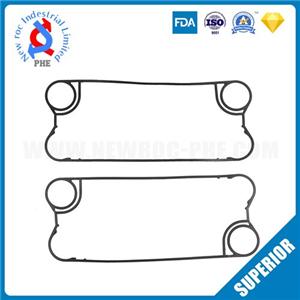Analyze the heat transfer performance of marine plate heat exchangers
The structure of the uid on both sides is cold water and hot water or lubricating oil. The heat exchange form between the plates can be abstracted as flat wall heat transfer.
Among them: λ is the thermal conductivity of water, and dε is the characteristic size of the plate. It can be known from fluid mechanics that when the flow of water begins to transition from laminar flow to turbulent flow, that is, after Re≥2200, the Nu number increases with the increase of Re number. The increase of the Re number depends on the increase of the water flow rate or the corrugation shape of the plate surface. From this we can see that increasing the flow rate of the fluid and the researched plate corrugation will be a means to strengthen the plate heat transfer.
Since the flow of fluid in the channel of the marine plate heat exchanger is determined by the heat exchange of the main engine diesel engine lubricating oil or liner water, the research point can be placed on the plate form.
Second, the main factors affecting the heat transfer of the plate
1. Plate thickness
It can be seen from the expression of the heat transfer coefficient that the smaller the thickness δ of the plate, the better the heat transfer of the heat exchanger. The standard of the marine plate heat exchanger proposes that the plate thickness of the heat exchanger is 0.6~0.8mm. The comparative titanium plate has reached 0.4mm. Thinning the plates will not be too useful to increase heat transfer, but the main purpose is to reduce costs and reduce material consumption, but the strength of the thin plates will be relatively reduced after pressing.
2. The angle of the plate
One of the main ways to increase the value of k in marine plate heat exchangers is to increase the degree of fluid disturbance on the surface of the heat exchange medium on both sides of the plate. The plates of marine plate heat exchangers are usually processed into herringbone corrugated plates. For the herringbone corrugated sheet, the size of the herringbone angle has a great influence on heat transfer and fluid resistance. Plates with large herringbone angles have high heat transfer coefficient and high fluid resistance; on the contrary, plates with small herringbone angles have low heat transfer coefficient and resistance.
In marine oil coolers, since the viscosity of the oil is higher than that of water, the use of plates with a large angle of 120° will cause large fluid resistance, while plates with a small angle of 60° have a low heat transfer coefficient. Therefore, lubricating oil coolers often use two kinds of plate mixing methods. When the allowable pressure drop is used, this is called a heat exchange hybrid design.
3. Flow velocity between plates
The flow rate of the fluid flowing between the plates is uneven. The flow velocity on the main flow line is about 4 to 5 times the average flow velocity. The flow velocity of each flow channel in a process is also uneven. In order to make the fluid flow between the plates in a turbulent state, the average flow velocity between the plates should be 0.3-0.8m/s. Take a larger value when the resistance drop is allowed to increase the convective heat transfer film coefficient, thereby reducing the heat exchange area and increasing the heat exchange efficiency. Usually select the appropriate single-piece area and aspect ratio of the plate according to a given flow rate. This selection method is a key factor in controlling the flow rate between the plates.




